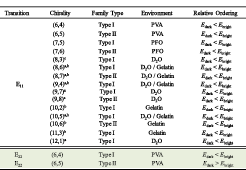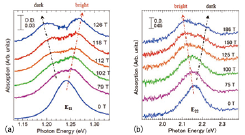Excitons Bright or Dark ? Revealed by Ultra-High Magnetic Fields in Carbon Nanotubes
Takeyama Group
Optical processes of semiconducting single-walled carbon nanotubes (SWNTs) are well-known to be dominated by pronounced exciton effects at their band edges [1]. Valley degeneracy and the spins in SWNTs connote very complicated exciton structures that comprise of a total of 16 excitonic states, among which only one state is optical dipole active (bright) and all others are optical dipole forbidden (dark) [2]. The ordering and relative energy splitting between these excitonic states, especially the ordering between bright and dark excitons, are crucial for optical device applications, since they essentially determine relaxation processes and thus the fate of optically or electrically generated carriers.

Table 1. Relative energy position of bright and dark excitons at the band-edge of the first and second sub-band in SWNTs dispersed in various materials. a: I. B. Mortimer et al., PRL 98, 027404 (2007); b: J. Shaver et al., Nano Lett. 7, 1851 (2007); c: I. B. Mortimer et al., PRB 76, 085404 (2007)

Fig. 1. Absorption spectral evolution of the (6, 5) SWNTs in high magnetic fields up to 186 T. (a) the first sub-band E11 transition; (b) the second sub-band E22 transition. Difference of the splitting peak evolution without any background contribution is unambiguous due to brightening of the original dark exciton energy position in the absence of magnetic field. O.D. stands for the optical density.
We carried out systematic high-field magneto-optical study on the relative ordering between bright and dark excitons in SWNTs for both 1st (E11) and 2nd (E22) sub-band transitions. Considering the fact that electronic properties of SWNTs usually show family patterns, we selected the (6,4) SWNTs as a representative for the Type I species ((2n+m) mod 3 =1) and (6,5) for the Type II species ((2n+m) mod 3=2) in our study. Highly selected chirality (6,4) and (6.5) SWNTs, respectively, were separated from a mixture of HiPco-grown SWNTs by single-surfactant multicolumn gel chromatography, which was recently developed [3]. The magnetic fields up to 190 T were generated in the single-turn coil ultra-high magnetic field generation system at the ISSP International MegaGauss Science Laboratory.
We have identified the relative energy position of the dark exciton by brightening it in ultra-high magnetic fields. We found that the 1st and 2nd sub-band transitions exhibit completely different characteristics [4]. For the 1st sub-band transition, the bright exciton appears to be higher in energy than its dark counterpart for any chiral species and is robust against environmental effect. While for the 2nd sub-band, their relative ordering was found to be chirality-sensitive: the bright exciton can be either higher or lower than the dark one, depending on the specific nanotube structures (summarized in Table 1). Figure 1 shows the absorption spectral evolution in magnetic fields for the case of (6,5) chirality categorized in TypeⅡ. E22 transition in Fig.1 (b) exhibits the typical behavior that the lowest energy state is bright, which is quite contrast to almost all semiconductor materials, wherein the dark excitons always locate at the lower energy side of the bright one. The unique chirality-sensitive bright-dark excitonic ordering discovered in this study renders us with possible controllability of the optical properties of SWNTs by manipulating the ordering of their exciton states. The choice of the family pattern could serve as a guide to select nanotubes with desired exciton structures. Thus, the findings in this work open up new possibilities for engineering the optical properties of SWNTs and will facilitate future commercial applications
References
- [1] F. Wang et. al., Science 308, 838 (2005).
- [2] T. Ando, J. Phys. Soc. Jpn. 75, 024707 (2006).
- [3] H. Liu et al., Nat. Commun. 2, 309 (2011).
- [4] W. Zhou, D. Nakamura, H. Liu, H. Kataura, and S. Takeyama, Scientific Reports 4, 6999 (2014).
